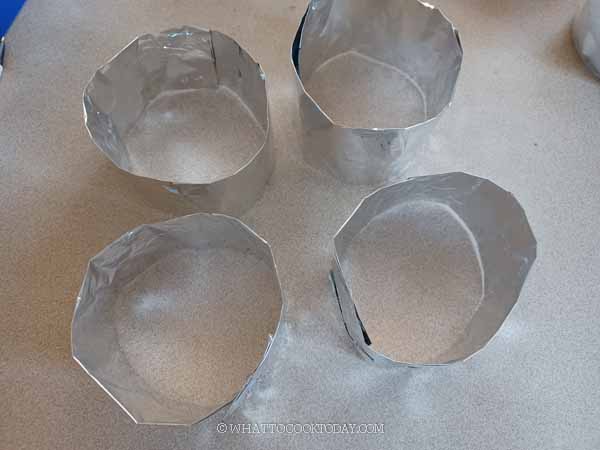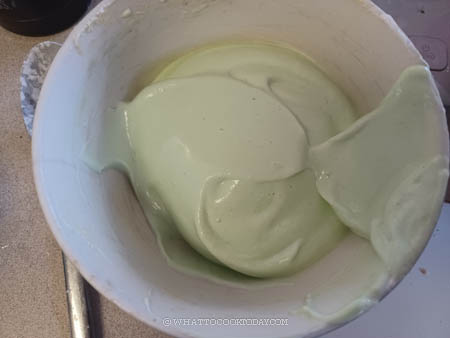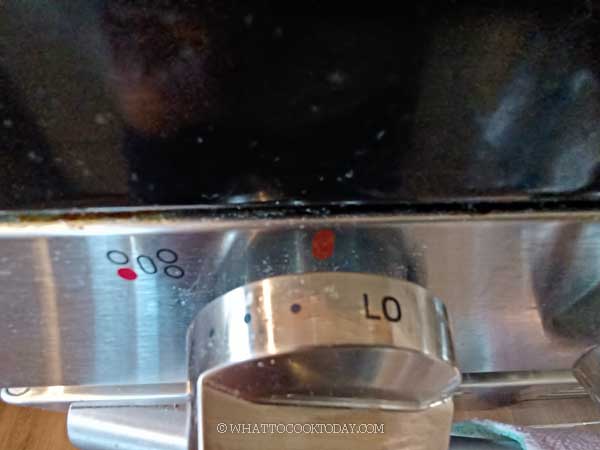This post may contain affiliate links. Please read our disclosure policy.
Learn how to make extra-tall pandan souffle pancakes that incredibly light, soft, and fluffy. It’s perfect to go with fresh fruit, butter, syrup of your choice, and some whipped cream.

Japanese souffle pancakes sure have taken on popularity in recent years, worldwide at that! In Indonesia for example, people were crazy about these Japanese souffle pancakes and are willing to line up, despite the long queue, to get these pancakes. This is also the same phenomenon in other countries.
What is a Japanese souffle pancake?
It is basically pancakes prepared using the souffle method, which involves beating the egg whites separately. The whipped egg whites contribute to the volume, light, and airy profile of the souffle. If you ask me, it’s like making a chiffon cake. Japanese souffle pancakes have some serious thickness to them, usually 3-4 times the thickness of the regular flat pancakes.
Is it hard to make Japanese pandan souffle pancakes?
I would say easy and hard at the same time. Easy because you don’t really need any special ingredients. It’s the same ingredients you use to make regular pancakes. So, what’s so hard about it? Well, glad you ask 🙂 For one, whipping egg white meringue can be a challenge for most people, especially if you have not much experience doing it. Folding the egg whites into the pancake batter is also another place where most people have trouble. Cooking these meringue-based pancakes on the stove without knowing the exact temperature is one of the biggest challenges for me. So, I hope by sharing some of the troubles I have here, you can replicate it without much issue. But if you do and it’s your first time doing it, don’t give up 😉

Important tips
1. Make sure there is no trace of grease in a bowl you are going to use to whip the egg whites. Make sure you use stainless steel or a glass bowl. Avoid plastic as it tends to have oil/grease residue that you can’t see
2. Whipping the egg white correctly is one of the keys to success in making souffle pancakes. You want to make sure you whip it to the firm peak, BUT do not overwhip the meringue
3. Do not cut down on the sugar amount. Sugar is necessary to make a stable meringue. The pancakes are just lightly sweetened in this recipe
4. I strongly suggest using a tinfoil ring (you can easily make these) to help hold the shape of the pancake and to keep it thick. If you have a round metal ring, that’s even better
5. Cook over low heat to prevent the bottom of the pancake from burning but the inside is still not cooked through
How to make Japanese Pandan Souffle Pancakes at home
1. You can use parchment paper or aluminum foil (I should have thought of this when I made these pancakes). The tinfoil is much sturdier than parchment paper. Cut out 4 strips, about 3 inches (7 cm) tall and about 12 inches (30 cm long). Fold in half so it is about 1 1/2 inches (3.5 cm) tall now and double layers. Form about 3-inch (8 cm) diameter ring. Secure with a stapler (tape didn’t work for me as they won’t adhere to the paper)

2. Make sure the eggs and milk are at room temperature. Separate the egg yolks from the whites. Combine cake flour, baking powder, and salt. Whisk the yolks, milk, oil, and pandan extract until combined

3. Sift in the cake flour mixture and whisk to combine until you get a thick but flowy batter

4. Preheat a large heavy-bottom non-stick pan that has a lid on the lowest heat. Rub with some oil using a paper towel. Make sure the bowl and the whisk from your electric mixer or stand mixer are squeaky clean with no trace of grease or you will have trouble whipping the egg whites. Please make sure the egg whites are at room temperature as well. Whisk the egg whites at medium-low speed (speed 4 on KA) until bubbly, about 1 minute. Add the vinegar and whisk again until the bubbles are fine, another minute. Add 1/3 of the sugar and continue to whisk for 1 minute, then the next 1/3 of the sugar and whisk another minute. Add the last 1/3 and increase speed to speed 6 continue to whisk until you get a stiff peak with a slight bent on the tip then switch to low speed, speed 2 and beat for about 1 minute and stop beating. When you turn the bowl upside down, the meringue won’t drip and the meringue looks shiny, fluffy, and smooth

5. Gently fold 1/3 of the meringue into the thick batter. Using a whisk, using a cutting motion and fold over to mix. Repeat this motion several rounds. Continue on with the second 1/3 of the meringue again to mix. For the last 1/3 of the meringue, use a rubber spatula instead to ensure you get all the batter at the bottom of the bowl mixed in as well. Use a cut down in the middle and fold over motion to fold gently but quickly. Make sure you don’t see any more white meringue

6. The mixture should be fluffy and voluminous

7. I recommend cooking 2 or at most 3 at a time, depending on the size of your skillet. Test the pan by dropping a few drops of water. It should be steaming gently. It shouldn’t be dancing around and evaporates almost immediately (indicating it’s too hot). If it is, lower the heat and wait for a minute or two, then try again.
 8. Place the rings on the pan. Pipe the batter into the rings or use a spoon to scoop the batter and fill the rings about 3/4 full. The batter will expand later. Smooth out the top of the batter
8. Place the rings on the pan. Pipe the batter into the rings or use a spoon to scoop the batter and fill the rings about 3/4 full. The batter will expand later. Smooth out the top of the batter

8. Put about 3-4 teaspoons of water on the empty spots on the pan. Close the lid. My stove has 9 heat levels and I use the a heat in between the 1st and 2nd. You may need to adjust yours. This is the challenge with baking on the stove, I can’t tell you the exact temperature. Cook for 10 minutes or until the pancake has risen to the top

9. Carefully remove the lid and slide your spatula underneath the pancake. It should be dry and nicely golden brown.
 10. Carefully and gently flip them over and add 2-3 more drops of water and quickly put the lid back on and cook for another 5 minutes
10. Carefully and gently flip them over and add 2-3 more drops of water and quickly put the lid back on and cook for another 5 minutes

11. The bottom is lightly golden brown and when you touch the top of the pancake is should be dry to touch and springs back if you gently push on it

12. Remove pancake from the pan and peel off the parchment paper and continue cooking the next batch. Don’t be surprised that the pancake will shrink some and that’s normal, but they will still be about 1 1/2-inch tall.
 13. Serve with some fresh fruit, butter, syrup of your choice or dusting of icing sugar if you like. A touch of whipped cream would be nice too. The color of the homemade pandan extract wasn’t deep enough as I ran out of pandan essence and so it’s kinda pale green here.
13. Serve with some fresh fruit, butter, syrup of your choice or dusting of icing sugar if you like. A touch of whipped cream would be nice too. The color of the homemade pandan extract wasn’t deep enough as I ran out of pandan essence and so it’s kinda pale green here.

This version below was baked in parchment paper ring, which you can see the side of the pancakes wrinkled more because the parchment paper that I have isn’t sturdy enough even though I have folded them multiple layers

Common problems with making Japanese Souffle Pancakes
1. The pancake batter is too liquidy
If that’s the consistency of the batter after all egg whites have been folded in, you have most likely deflated the meringue and ended up with that consistency. Another possibility is the meringue is not whipped enough that it doesn’t have much air. The correct consistency should be light, airy, and tripled by volume
2. The cake batter and egg white meringue are hard to combine
If you whip the egg whites to the point where it clumps into a big chunk on the whisk, most likely you have over whip the meringue and when you try to combine it with the pancake batter, it separates into foams and is hard to combine
3. The pancakes deflate badly
Most likely you may not whip up the meringue to the right consistency or you may have deflated most of the air when you fold the egg whites into the batter. You may have cooked them on too high of heat that they rise too quickly, which means they will deflate quickly too
Did you make this pandan souffle pancakes recipe?
I love it when you guys snap a photo and tag to show me what you’ve made 🙂 Simply tag me @WhatToCookToday #WhatToCookToday on Instagram and I’ll be sure to stop by and take a peek for real!

Extra Tall Soft Fluffy Pandan Souffle Pancakes
Ingredients
Pancake batter:
- 2 egg yolks from 58-60 gram egg with the shell
- 20 ml milk
- 10 gr plain unsweetened yogurt
- ½ tsp pandan extract or use vanilla extract
- 35 gr cake flour
- ⅛ tsp salt
- ¼ tsp baking powder
Meringue:
- 2 egg whites
- 35 gr icing sugar
- ¼ tsp vinegar
Instructions
Prepare ring molds:
- Use aluminum foil to make the rings. The foil is much sturdier than parchment paper. Cut out 4 strips, about 3 inches (7 cm) tall and about 12 inches (30 cm long). Fold in half so it is about 1 1/2 inches (3.5 cm) tall now and double layer. Form about 3-inch (8 cm) diameter ring. Secure with a stapler (tape didn't work for me as they won't adhere to the paper)
- If you have a round ring mold about 3 or 4-inch size, you can use that and brush with some oil. If you do a 4-inch pancake, you'll get about 3 pancakes
Prepare the pancake batter:
- Make sure the eggs, milk, and yogurt are at room temperature. Separate the egg yolks from the whites. Combine cake flour, baking powder, and salt. Whisk the yolks, milk, oil, and pandan extract until combined. Sift in the cake flour mixture and whisk to combine until you get a thick but flowy batter
Preheat pan:
- Preheat a large heavy-bottom non-stick pan that has a lid on the lowest heat. Rub with some oil using a paper towel
- You can also use an electric griddle that has a lid or anything that you can use as a lid to cover during baking on the stove. Preheat on the lowest heat setting and rub with some oil using a paper towel
Prepare the meringue:
- Make sure the bowl and the whisk from your electric mixer or stand mixer are squeaky clean with no trace of grease or you will have trouble whipping the egg whites. Please make sure the egg whites are at room temperature as well
- Whisk the egg whites at medium-low speed (speed 4 on KA) until bubbly, about 1 minute. Add the vinegar and whisk again until the bubbles are fine, another minute. Add 1/3 of the sugar and continue to whisk for 1 minute, then the next 1/3 of the sugar and whisk another minute. Add the last 1/3 and increase speed to speed 6 continue to whisk until you get a stiff peak with a slight bent on the tip then switch to low speed, speed 2 and beat for about 1 minute and stop beating. When you turn the bowl upside down, the meringue won't drip and the meringue looks shiny, fluffy, and smooth
- How to know if the meringue is overbeaten: The meringue is coarse, dull, and grainy. It also clumps on the whisk in a really large chunk. It will be difficult to mix with the pancake batter as they will separate and most likely you'll end up deflating the meringue. I suggest to start over if your meringue is over beaten
Folding meringue into the batter:
- Gently fold 1/3 of the meringue into the thick batter. Using a whisk, using a cutting motion and fold over to mix. Repeat this motion several rounds. Continue on with the second 1/3 of the meringue again to mix. For the last 1/3 of the meringue, use a rubber spatula instead to ensure you get all the batter at the bottom of the bowl mixed in as well. Use a cut down in the middle and fold over motion to fold gently but quickly. Make sure you don't see any more white meringue. The mixture should be fluffy and voluminous
- You can transfer the batter to a piping bag or just use a spoon to transfer the batter
Baking on the stove:
- I recommend cooking 2 or at most 3 at a time, depending on the size of your skillet. Test the pan by dropping a few drops of water. It should be steaming gently. It shouldn't be dancing around and evaporates almost immediately (indicating it's too hot). If it is, lower the heat and wait for a minute or two, then try again
- Place the rings on the pan. Pipe the batter into the rings or use a spoon to scoop the batter and fill the rings about 3/4 full. The batter will expand later. Smooth out the top of the batter
- Put about 3-4 teaspoons of water on the empty spots on the pan. Close the lid. My stove has 9 heat levels and I use the 2nd lowest heat. You may need to adjust yours. This is the challenge with baking on the stove, I can't tell you the exact temperature. Cook for 10 minutes or until the pancake has risen to the top
- Carefully remove the lid and slide your spatula underneath the pancake. It should be dry and nicely golden brown. Carefully and gently flip them over and add 2-3 more drops of water and quickly put the lid back on and cook for another 5 minutes or until the bottom is lightly golden brown and when you touch the top of the pancake is should be dry to touch and springs back if you gently push on it
- Remove pancake from the pan and peel off the parchment paper and continue cooking the next batch. Don't be surprised that the pancake will shrink a bit and that's normal, but they will still be at least 1 1/2-inch tall
- If your souffle pancake deflates a lot almost immediately, you probably didn't whip the meringue correctly or deflating most of the air when you fold the meringue into the batter
To serve:
- Serve with some fresh fruit, butter, syrup of your choice or dusting of icing sugar if you like. A touch of whipped cream would be nice too
- Japanese souffle pancakes are best served right after you make them


